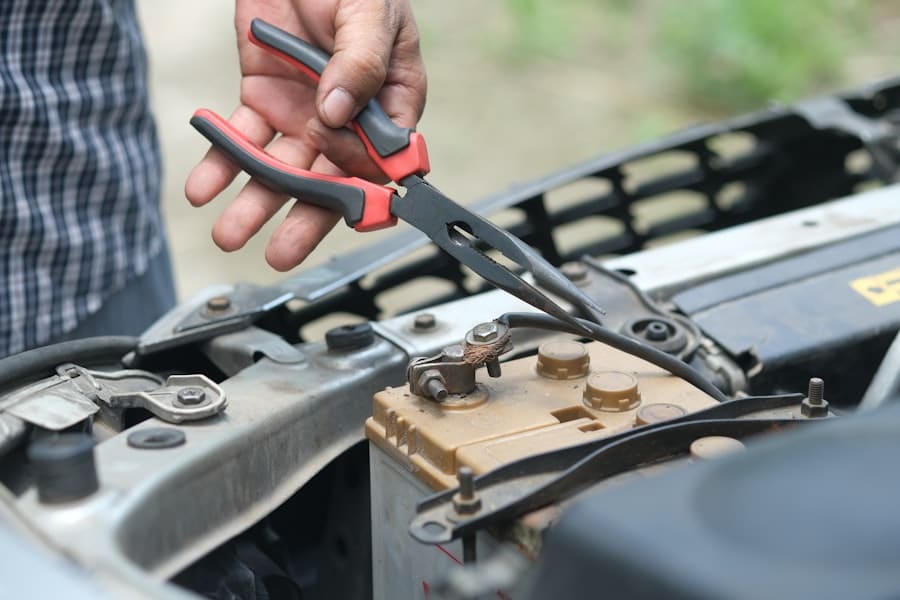Machine vision has emerged as a transformative technology in the realm of automated quality assurance, revolutionizing how industries monitor and maintain product quality. At its core, machine vision refers to the use of computer algorithms and imaging systems to enable machines to interpret and understand visual information from the world around them. This technology is particularly vital in manufacturing environments where precision and consistency are paramount.
By employing cameras and sophisticated software, machine vision systems can inspect products at high speeds, ensuring that they meet predefined quality standards without the need for human intervention. The integration of machine vision into quality assurance processes has led to significant improvements in efficiency and accuracy. Traditional quality control methods often rely on manual inspection, which can be time-consuming and prone to human error.
In contrast, machine vision systems can analyze thousands of images per minute, detecting defects that may be invisible to the naked eye. This capability not only enhances the reliability of quality assessments but also allows for real-time feedback in production lines, enabling immediate corrective actions when deviations from quality standards are detected. As industries continue to seek ways to optimize their operations, machine vision stands out as a critical component in the evolution of automated quality assurance.
Key Takeaways
- Machine vision plays a crucial role in automated quality assurance by using cameras and image processing algorithms to inspect and analyze products.
- Advancements in machine vision technology, such as improved image resolution and faster processing speeds, have enhanced its capabilities in detecting defects and ensuring product quality.
- Integrating machine vision into automated quality assurance systems allows for real-time inspection, reducing the need for manual intervention and improving production efficiency.
- The benefits of using machine vision in quality assurance include higher accuracy, increased inspection speed, and the ability to handle complex inspection tasks.
- Despite its advantages, machine vision in quality assurance faces challenges such as high initial costs, the need for skilled personnel to set up and maintain systems, and limitations in handling certain types of inspections.
Advancements in Machine Vision Technology
The field of machine vision has witnessed remarkable advancements over the past few years, driven by innovations in hardware and software technologies.
High-resolution cameras equipped with advanced sensors can capture images with exceptional clarity, allowing for more detailed inspections.
Additionally, the advent of 3D imaging technologies has enabled systems to assess the dimensional accuracy of products, providing a more comprehensive evaluation than traditional 2D imaging alone. Software advancements have also played a crucial role in the evolution of machine vision. The integration of artificial intelligence (AI) and machine learning algorithms has enabled systems to learn from vast datasets, improving their ability to identify defects and anomalies over time.
For instance, deep learning techniques can be employed to train models that recognize complex patterns in images, significantly enhancing defect detection capabilities. Furthermore, the development of user-friendly interfaces has made it easier for operators to set up and manage machine vision systems, reducing the barrier to entry for companies looking to implement this technology.
Integration of Machine Vision in Automated Quality Assurance Systems

Integrating machine vision into automated quality assurance systems involves a multifaceted approach that encompasses hardware selection, software configuration, and system architecture design. The first step typically involves selecting appropriate imaging hardware that aligns with the specific requirements of the production environment. Factors such as lighting conditions, object size, and required resolution must be considered to ensure optimal performance.
For example, in a food processing plant, specialized cameras may be used to detect foreign objects or contaminants in products, necessitating careful consideration of hygiene standards and environmental factors. Once the hardware is in place, the next phase involves configuring the software to process and analyze the captured images effectively. This often includes setting up algorithms for image processing, defect detection, and data analysis.
The integration process may also involve connecting the machine vision system with existing manufacturing execution systems (MES) or enterprise resource planning (ERP) systems to facilitate seamless data flow and reporting. By doing so, manufacturers can achieve a holistic view of their production processes, enabling them to make informed decisions based on real-time quality data.
Benefits of Using Machine Vision in Quality Assurance
The adoption of machine vision technology in quality assurance offers numerous benefits that extend beyond mere defect detection. One of the most significant advantages is the enhancement of operational efficiency. By automating inspection processes, manufacturers can reduce labor costs associated with manual inspections while simultaneously increasing throughput.
This efficiency gain is particularly evident in high-volume production environments where speed is critical. Moreover, machine vision systems contribute to improved product consistency and reliability. By ensuring that every product is inspected against stringent quality criteria, manufacturers can minimize variations that may lead to customer dissatisfaction or product recalls.
This consistency not only bolsters brand reputation but also fosters customer loyalty as consumers increasingly demand high-quality products. Additionally, machine vision systems can provide valuable data analytics that inform continuous improvement initiatives, allowing organizations to refine their processes over time.
Challenges and Limitations of Machine Vision in Quality Assurance
Despite its many advantages, the implementation of machine vision in quality assurance is not without challenges. One significant hurdle is the initial investment required for hardware and software acquisition. While costs have decreased over time, small and medium-sized enterprises may still find it challenging to allocate sufficient resources for a comprehensive machine vision system.
This financial barrier can hinder widespread adoption across various industries. Another challenge lies in the complexity of setting up and maintaining machine vision systems. The need for specialized knowledge in optics, image processing, and software programming can create a skills gap within organizations.
Additionally, environmental factors such as lighting variations or surface reflectivity can impact the performance of machine vision systems, necessitating ongoing calibration and adjustments. These challenges underscore the importance of thorough planning and training when integrating machine vision into quality assurance processes.
Future Trends in Machine Vision for Quality Assurance

As technology continues to evolve, several trends are shaping the future of machine vision in quality assurance. One notable trend is the increasing integration of artificial intelligence (AI) into machine vision systems. AI algorithms are becoming more sophisticated, enabling systems to not only detect defects but also predict potential quality issues before they arise.
This predictive capability allows manufacturers to implement proactive measures that enhance overall product quality. Another emerging trend is the use of cloud-based solutions for machine vision applications. By leveraging cloud computing resources, manufacturers can store vast amounts of image data and utilize powerful processing capabilities without investing heavily in on-premises infrastructure.
This shift towards cloud-based solutions facilitates remote monitoring and management of quality assurance processes, enabling organizations to respond quickly to issues regardless of their physical location.
Industry Applications of Machine Vision in Quality Assurance
Machine vision technology finds applications across a diverse range of industries, each benefiting from its unique capabilities in quality assurance. In the automotive sector, for instance, machine vision systems are employed to inspect components such as welds and paint finishes for defects that could compromise safety or aesthetics. High-speed cameras can capture images during assembly processes, ensuring that every part meets stringent quality standards before moving on to subsequent production stages.
In pharmaceuticals, machine vision plays a critical role in ensuring product integrity and compliance with regulatory standards. Systems are used to inspect packaging for proper labeling and verify that expiration dates are clearly printed on containers.
The Impact of Machine Vision on the Future of Quality Assurance
The impact of machine vision on the future of quality assurance is profound and far-reaching. As industries increasingly embrace automation and digital transformation, machine vision stands at the forefront of this evolution, offering solutions that enhance efficiency, accuracy, and reliability in quality control processes. The ability to conduct real-time inspections at unprecedented speeds not only streamlines operations but also elevates product standards across various sectors.
Looking ahead, as advancements in AI and cloud computing continue to reshape the landscape of machine vision technology, we can expect even greater integration into automated quality assurance systems. The potential for predictive analytics will empower manufacturers to anticipate issues before they escalate into costly problems, further solidifying machine vision’s role as an indispensable tool in modern manufacturing environments. As organizations strive for excellence in product quality and customer satisfaction, machine vision will undoubtedly play a pivotal role in shaping the future of quality assurance practices across industries worldwide.
If you are interested in the latest technology trends, you may also want to check out this article on the best Apple tablets for 2023. Stay ahead of the curve with the most up-to-date information on cutting-edge devices and gadgets.
FAQs
What is machine vision in automated quality assurance?
Machine vision in automated quality assurance refers to the use of cameras and image processing algorithms to inspect and analyze products for defects or deviations from quality standards in a manufacturing environment. This technology allows for high-speed and accurate inspection of products, reducing the need for manual inspection and improving overall quality control processes.
What are the benefits of using machine vision in automated quality assurance?
Some of the benefits of using machine vision in automated quality assurance include improved product quality, increased production efficiency, reduced labor costs, and the ability to detect defects that may not be visible to the human eye. Additionally, machine vision systems can provide valuable data and insights for process optimization and continuous improvement.
What are the key applications of machine vision in automated quality assurance?
Machine vision in automated quality assurance is commonly used for tasks such as inspecting for surface defects, measuring dimensions, verifying assembly correctness, reading codes and labels, and identifying product flaws. These applications are widely used in industries such as automotive, electronics, pharmaceuticals, food and beverage, and more.
What are the current trends in the future of machine vision in automated quality assurance?
Some current trends in the future of machine vision in automated quality assurance include the integration of artificial intelligence and deep learning algorithms for more advanced defect detection and classification, the use of 3D imaging for more comprehensive inspections, and the development of more compact and cost-effective vision systems for smaller manufacturers.
What are the challenges in implementing machine vision in automated quality assurance?
Challenges in implementing machine vision in automated quality assurance include the initial investment in equipment and training, the need for expertise in developing and maintaining vision systems, and the potential for false positives or negatives in defect detection. Additionally, adapting to varying lighting and environmental conditions can also be a challenge.


Add a Comment